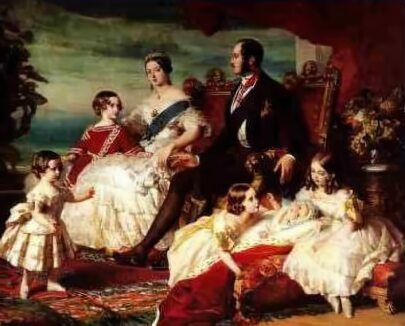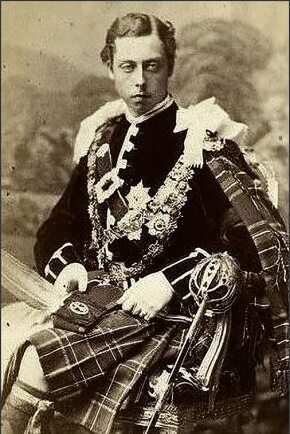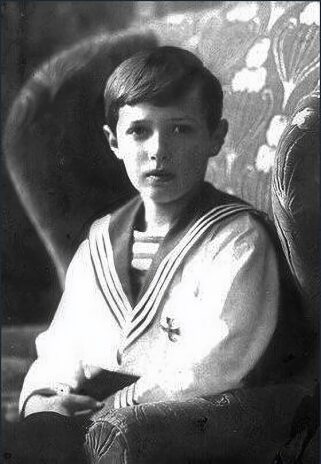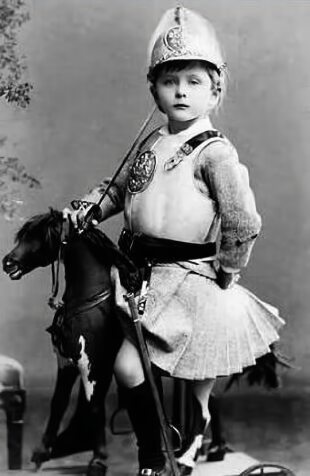Does the Royal Family of England Still Carry the Gene for Haemophilia?
Haemophilia
Haemophilia acquired the name the royal disease due to the loftier number of descendants of Queen Victoria afflicted by it. The first example of haemophilia in the British Imperial family occurred on the nativity of Prince Leopold on 7th April 1853, Leopold was the 4th son and 8th child of Queen Victoria and Prince Albert of Saxe-Coburg-Gotha. No earlier occurrence of the disease in the Royal family had been known, it is assumed that a mutation occurred in the sperm of the Queen's father, Edward Augustus, Duke of Kent.
Victoria and Albert and their eldest v children 
Haemophilia is an X-linked recessive disorder. The blood of a haemophiliac cannot coalesce, due to the fact that one or more of the plasma proteins required to class a clot is absent or reduced in their blood. The status is passed on to males through females, who do non manifest the symptoms of the illness themselves. A recessive factor, it is carried on the sexual female chromosome 10 . Males possess XY chromosomes and females XX. Since females take two Ten chromosomes, they are by and large carriers.
Prince Leopold, Knuckles of Albany (1 on nautical chart), the get-go of Queen Victoria's descendants to suffer from haemophilia was described equally a frail child who remained a abiding source of anxiety to the Queen throughout his life, evidence exists that Leopold also suffered mildly from epilepsy, like his thou-nephew Prince John (the youngest son of King George 5). He was get-go diagnosed with haemophilia in 1858 or 1859, Queen Victoria consequently placed restrictions on him, which he chaffed at. He was later created Duke of Albany and married the German princess, Helena of Waldeck-Pyrmont. Leopold died in 1884 at the age of 31, in the due south of France. He suffered a fit, the cause or the outcome of a fall on some stairs at Cannes, injuring his knee and hitting his head and died the post-obit morning time, plainly from a cerebral haemorrhage.
Prince Leopold, Duke of Albany 
Leopold was the only one of Queen Victoria's haemophiliac descendants to accept children, his spousal relationship to Helena of Waldeck produced two children, a daughter, Princess Alice of Albany (4), subsequently to become Countess of Athlone, who was a further carrier of the illness and an unaffected son, built-in posthumously, Charles Edward, later Duke of Saxe-Coburg-Gotha. Alice was after to go Countess of Athlone and was to testify a carrier of haemophilia. She married Prince Alexander of Teck, the brother of Queen Mary, their son, Rupert Alexander George of Teck. During the First World War, when anti-German feeling was at its height, in conjunction with changing the name of the Imperial Firm to Windsor, King George Five changed that of the Tecks to Cambridge, (for their maternal ancestor, Adolphus, Duke of Cambridge, a son of George III). Alexander of Teck was made Earl of Athlone and Rupert granted the courtesy title of Viscount Trematon. Viscount Trematon (5) was also a haemophiliac. He died on xv April 1928 from an intracerebral haemorrhage every bit a result of a car crash in France. On ane April 1928, Rupert was driving with two friends Paris to Lyon. In the course of overtaking another vehicle, his auto hit a tree and overturned. He was taken to a nearby hospital with a skull fracture but never recovered and died in hospital.
Through two of the Queen's daughters, Princess Alice, Grand Duchess of Hesse (2) and Beatrice, Princess of Battenberg (3), both of whom were carriers, the illness was to exist spread into many of the Royal Families of Europe.
Tsarevich Alexei 
Princess Alice was married to Prince Louis of Hesse-Darmstadt and gave birth to a haemophiliac son, Frederick of Hesse (6), (Frederick William August Victor Leopold Louis) known as Frittie in the family unit, in 1870. His haemophilia was beginning diagnosed in February 1873, a few months before his decease, when he cutting his ear and bled for three days. He died very young in 1873, after a autumn from a window induced a encephalon haemorrhage. Tragically, the kid bled to death, leaving his female parent inconsolable. Alice too had an unaffected son, the futurity Grand Duke Ernest Louis of Hesse and five daughters. Two of the daughters, Irene (seven) and Alix of Hesse(8) were in turn, carriers of the haemophilia gene.
Haemophilia appeared in the Prussian Purple family when Alice's tertiary daughter Irene married her start cousin, Prince Henry of Prussia, the second son of Queen Victoria'due south eldest daughter Victoria, Princess Royal and brother of Kaiser Wilhelm Ii. The disease appeared in two of their sons Princes Waldemar (9) and Henry of Prussia (x). Prince Waldemar died in a clinic in Tutzing, Bavaria during the Second Earth War due to a lack of blood transfusion facilities. He and his wife fled before the Russian advance, arriving in Tutzing, Waldemar needed a blood transfusion simply the U.S. Regular army overran the area and diverted all available medical resource to care for concentration camp victims, preventing Waldemar'southward High german md from treating him, Waldemar died the following mean solar day, on 2 May 1945. His brother Prince Henry died at the age of 4 on 26 Feb 1904, from a brain bleeding, the issue of a fall from a chair.
The disease was spread to the Romanov dynasty through the union of Alice's fourth daughter Alix, to Tsar Nicholas II, at which she became the Empress Alexandra of Russian federation. The highly bonny Alix had previously refused a proposal from Albert Victor, Duke of Clarence and Avondale, and heir to the British throne, the eldest son of Bertie, Prince of Wales. Had she accepted, haemophilia could have re-entered the British Royal line. Nicholas had long loved and cherished dreams of marrying Alix, just she turned downwardly his commencement proposal as she could not bring herself to change her Protestant religion to the Russian Orthodoxy required of a futurity Tsarina, but afterwards much soul searching, accustomed when Nicholas proposed for a second time.
Alix, who became known equally Empress Alexandra, produced four daughters before giving birth to their but son, the Tsarevitch Alexis (11), heir to the Russian empire, who was as well stricken with haemophilia. Equally with most female parent's of haemophiliacs, Alix was overprotective of her son and worried about him constantly. Through his supposed ability to heal Tsarevich, and Tsarina'south conviction in him, Rasputin acquired a fatal influence over the Tsar's decisions which was to pb directly to the Russian Revolution. The unabridged family perished at the hands of a Bolshevik firing team in a cellar at Ekaterinberg on 17th July 1918.
The Queen'southward youngest girl, Princess Beatrice, cruel in love with and married the handsome Prince Henry of Battenberg. The couple produced three sons and a daughter. Two of their sons, Leopold Mountbatten (12) and Maurice, Prince of Battenburg (13) inherited the haemophilia factor from their mother. Maurice was killed whilst engaged in active service in the Ypres Salient during the Start World War. Leopold (Leopold Arthur Louis) lived to the age of 32, dying during a hip operation in 1922.
Leopold Mountbatten 
Beatrice'due south but daughter, Victoria Eugenie of Battenburg (14), known as Ena, was married to Male monarch Alfonso XIII of Spain and carried the disease into the Purple Firm of Spain.
Though they did not enjoy a particularly happy wedlock and Alfonso had many mistresses, the couple produced six children, four sons and two daughters. 2 of their sons, Alfonso, Prince of the Asturias (15), the heir to Spain, and Infante Gonzalo of Spain (16), were affected with haemophilia. Alfonso is reported to have never forgiven his wife for passing the disease into the Castilian Royal bloodline. Both children were dressed in padded suits to prevent their undergoing knocks which might upshot in a life-threatening bleeding.
Alfonso later renounced his rights to the throne of Espana to marry a commoner, Edelmira Sampedro Ocejo y Robato, after which he took the courtesy title Count of Covadonga. A car accident led to his early expiry in 1938, when he crashed into a telephone booth and appeared to take pocket-size injuries, but his haemophilia led to fatal internal haemorrhage. Another of Victoria Eugenie's sons Juan was the male parent of Juan Carlos, the present King of Spain's male parent.
In Baronial 1934 the Infante Gonzalo of Spain was spending the summer holidays with his family unit at the villa of Count Ladislaus Hoyos at Pörtschach am Wörthersee in Austria. The infante Gonzalo died as a result of a traffic blow, he and his sister the Infanta Beatriz were driving from Klagenfurt to Pörtschach. On budgeted Krumpendorf, Beatriz, who was driving the vehicle, was forced to swerve to avert a cyclist, resulting in the car beingness crashed into a wall. Since neither Gonzalo nor Beatriz appeared desperately hurt, they returned to their villa. Several hours later it became clear that Gonzalo had severe intestinal bleeding and died ii days later. Porphyria in the Imperial Family
Source: https://www.englishmonarchs.co.uk/haemophilia.html
Post a Comment for "Does the Royal Family of England Still Carry the Gene for Haemophilia?"